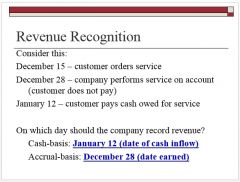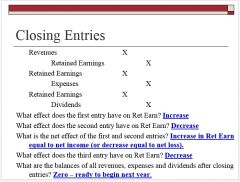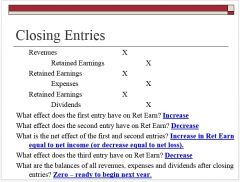![]()
![]()
![]()
Use LEFT and RIGHT arrow keys to navigate between flashcards;
Use UP and DOWN arrow keys to flip the card;
H to show hint;
A reads text to speech;
28 Cards in this Set
- Front
- Back
|
How are revenues and expenses recorded in cash-basis accounting? |
Record revenues when cash is received
Record expenses when cash is paid |
|
|
How are revenues and expenses recorded in accrual-basis accounting? |
Record revenues when earned
Record expenses in period the benefit is received |
|
|
What is the definition of the revenue recognition principle? |
Record revenue when earned |
|

|

|
|
|
Define Matching principle |
All costs that are used to generate revenue are recorded as expenses in the period the revenue is recognized. |
|
|
Why is accrual-basis preferred over cash-basis?(3 reasons) |
1. Truer recognition of assets and liabilities 2. Better matching of revenues and expenses 3. Better indication of future cash flows |
|
|
Generally, all companies use what kind of accounting, accrual or cash basis? |
Accrual-basis |
|
|
What are the 3 types of adjusting entries? |
1. Deferrals 2. Accruals 3. Depreciation |
|
|
What are deferrals? What are the two types? |
Deferrals: Paid or received cash in advance - Prepaid expenses: paid cash for the purchase of an asset before incurring the expense. - Unearned revenues: received cash and recorded a liability before earning the revenue.
|
|
|
What are accruals? |
Accruals: the opposite of deferrals - Accrued expenses: paid cash after incurring the expense and recording a liability - Accrued revenues: received cash after earnings the revenue and recording an asset. |
|
|
REVIEW ADJUSTING ENTRIES SLIDES STARTING AT CHAPTER 3A POWERPOINT SLIDE 19 |
REVIEW ADJUSTING ENTRIES SLIDES STARTING AT CHAPTER 3A POWERPOINT SLIDE 19 |
|
|
REVIEW TRIAL BALANCE AND ADJUSTED TRIAL BALANCE SLIDES STARTING AT CHAPTER 3A POWERPOINT SLIDE 46 |
REVIEW TRIAL BALANCE AND ADJUSTED TRIAL BALANCE SLIDES STARTING AT CHAPTER 3A POWERPOINT SLIDE 46 |
|
|
All _________ ____________ accounts represent activity over the entire life of the company |
balance sheet |
|
|
All ________ _________ (and dividend) accounts represent activity for the current period only. |
income statement |
|
|
What kind of accounts must be closed to get them ready for the next period(start at zero)? |
Temporary Accounts |
|

KNOW THIS SLIDE FOR CLOSING ENTRIES(SLIDE 31 CHAPTER 3B PPT) |

KNOW THIS SLIDE FOR CLOSING ENTRIES(SLIDE 31 CHAPTER 3B PPT) |
|
|
What accounts are temporary and need to be closed at the end of the year?(Slide 34 Chapter 3B PPT) |
1. Revenues 2. Expenses 3. Dividends |
|
|
When closing all temporary accounts, where is everything transferred?(Slide 35 Chapter 3B PPT) |
Into Retained Earnings a permanent account |
|
|
LEARN HOW TO DO CLOSING ENTRIES AND HOW TO ADD THEM INTO RETAINED EARNINGS WITH THE T ACCOUNT(Slide 35-38 Chapter 3B PPT) |
LEARN HOW TO DO CLOSING ENTRIES AND HOW TO ADD THEM INTO RETAINED EARNINGS WITH THE T ACCOUNT(Slide 35-38 Chapter 3B PPT) |
|
|
What is liquidity? |
How quickly an item can be converted to cash |
|
|
What is the classified balance sheet used for? |
Classify assets and liabilities as current or long-term based on liquidity |
|
|
In the Classified Balance sheet, how are assets and liabilities categorized? |
Assets: Current Assets Long-Term Assets Intangible Assets
Liabilities Current Liabilities Long-Term Liabilities |
|
|
In the Classified Balance sheet, how are assets classified from most liquid to not liquid? |
Cash Most Liquid Accounts Receivable Very Liquid Inventory Somewhat Liquid Property,Plant,& Equipment Not Liquid |
|
|
Accounting Cycle, quick 3 step process:(Slide 18 Chapter 3b PPT)
|

|
|
|
What is the full 10 step accounting cycle in order?(Slide 15 Chapter 3b PPT) |

|
|
|
Net working capital ratio equation and what does it show? |
Networking capital = current assets - current liabilities
This ratio shows operating liquidity, higher amount = higher liquidity |
|
|
current ratio equation and what does it show? |
current ratio = current assets/current liabilities
This ratio shows the ability to pay current debt, higher ratio = lower risk |
|
|
Debt ratio equation and what does it show? |
debt ratio = total liabilities/total assets
This ratio shows the proportion of resources financed with debt, higher ratio = higher risk |

